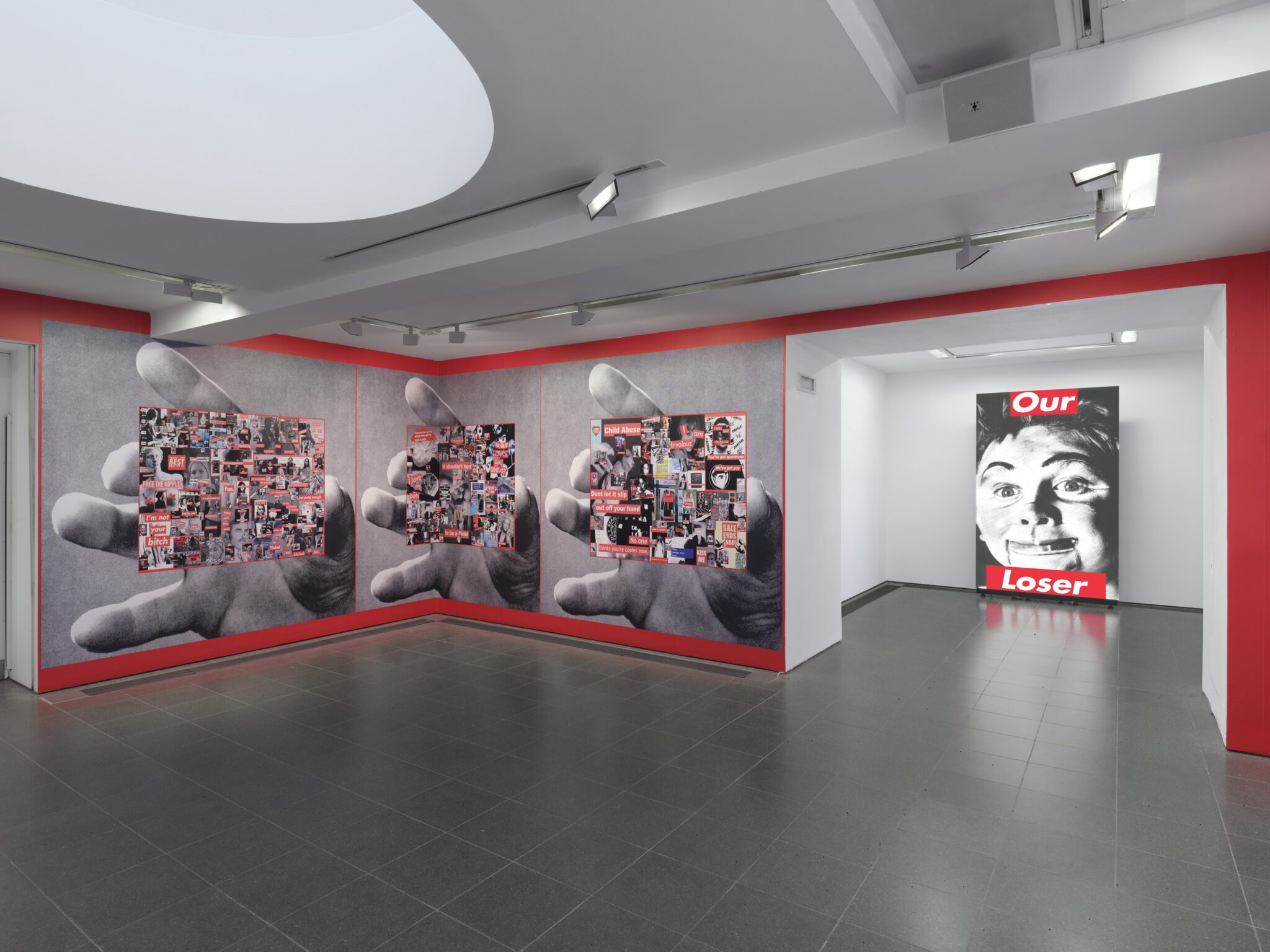Barbara Kruger: Thinking of You. I Mean Me. I Mean You.

Nick Moss reviews Barbara Kruger: Thinking of You. I Mean Me. I Mean You., at the Serpentine South Gallery to 17 March 2024. Above image: Installation view, photo by George Darrell
Barbara Kruger’s work has been exhibited surprisingly infrequently in the UK. However, the success of her interventions in relation to abortion rights and the struggle for women’s rights more generally – the early billboard works carrying texts stating “Your gaze hits the side of my face”, “Your body is a battleground”; the New York magazine cover that reads “Who Becomes a “Murderer” in Post-Roe America ?” – means there is a resonant familiarity to these works.
They are works as often encountered outside the gallery space as within – and outside the gallery space is where their subversive intent is perhaps most effectively realised. For me, I first encountered her work when she designed the sleeve for the industrial/hip-hop band Consolidated’s album The Business of Punishment.
The Serpentine exhibition continues her attempts to reach beyond the gallery. Three London taxis have been decorated with texts from the works here. Obviously, these will serve to promote the exhibition, but the chance encounter with Kruger’s work is when her art of subversion has its real impact. These are what Kruger calls “moments of recognition” -when the slogan twisted against itself captures something about the way your life can be twisted against its own interests:
When my work is seen in public spaces, it’s not important that people know it’s me or my work – it's just the meaning that they’re seeing and the connections that they might make between image and text and sound. That’s more important to me. I don’t care if it’s identified as an artwork or if my name is on it.
Kruger uses the visual language of advertising to “to try to detonate some kind of feeling or understanding of lived experience.” She worked as a graphic designer and picture editor for Conde Nast’s Mademoiselle magazine in the 1960s, then as freelance picture editor for House and Gardens.
Coming from a working-class Newark, New Jersey background, she improvised an artistic style from her background in graphic design. As she states in the interview with Hans Ulrich Obrist that accompanies the exhibition:
I just had to figure out what it might mean to call myself an artist – I needed to understand what really engages me. I had to figure out what really struck a match in me, rather than just a stylistic choice that would become my art.
In common with contemporaries like Jenny Holzer and Art & Language, she became fascinated with type – primarily with sans-serif – and the way “they made a strong overture to the viewer and reader” and with the way the language of advertising and its use of direct address, establishes what might be called value claims, and how these value claims might be subverted.
Kruger’s art, as she puts it, is “about how we are to one another, and that means how we respect one another, how we detest one another, our adorations , our contempt, the centuries of worship and subjugation, of brutality and kindness.”
But the works are about more than that – they are about how human relationships, dialogues between peoples, become pervaded and polluted and distorted by a kind of institutional language – a toxic, miasmatic emanation of a kind of non-language (if language is a bridge from one person to another) which is really a series of commands – to shop, to dress, to obey.
Kruger has for years now been waging a permanent war against all this, and this exhibition shows how in the process she adapts, revises and revisits works to meet technological changes and challenges.
The Serpentine exhibition gives many examples of how these adaptations are worked through. Your Body Is a Battleground – originally created for the 1989 Women’s March on Washington, is presented as a video where a woman’s face is split and re-assembled into a divide of contrasting colours – the body as a frontline.
The newest work, No Comment, is a three-screen video installation compiled from found video and audio drawn from TikTok, YouTube, Fox News et al, with Trump, cats, hairstylists and acrobats combining to present a cacophony of hostile banality which Kruger periodically interrupts with statements from Voltaire and Kendrick Lamar among others, which derail and disrupt the ranting, tumbling, hurtling procession.
Kruger has said that one of the reasons she thinks her work has an impact is because it capitalises on:
what I think is predominant in the world and something that I share, which is a short attention span. I believe it’s possible to make work and meanings that engage those short attention spans, that encourage them to linger a little bit.
One of the ironies Kruger has scathingly embraced is the attempt by hipster skatewear label Supreme to appropriate her signature white-on-red Futura Bold Italic text in its graphics. In response, her original “I shop therefore I am” is reworked here through a number of variations ending with “I die therefore I was.” Elsewhere, a skateboard carries the graphic ”Dont Be a Jerk.”
Kruger’s work has an obvious link back to Situationism’s practice of detournement, but whereas Situationist practice was rooted in an attempt to stimulate anti-system activity, Kruger’s work – at least as it exists now – lacks that revolutionary kernel. The subversive joy of her work has, in the face of the rise and resurgence of Trump, taken a didactic turn.
One piece here, The Work Is, runs through a description of the intended purpose of her work:
The work is about...audience and the scrutiny of judgment...fashion and the imperialism of garments, community and the discourse of self-esteem, witnessing and the anointed moment, spectacle and the enveloped viewer, narrative and the gathering of incidents, simultaneity and the elusive now, digitals and the rush of the capture.
You keep waiting for something to happen to mock the sanctimony, for a YouTube cat to pounce or a turd emoji to float across the screen, but it just scrolls on and on. I know Kruger has the best intentions, but this spelling-out implies a lack of faith in both her best work and in her audience.
The Serpentine education room, the window of which looks out onto Hyde Park, is covered with black and white text, Orwell’s “If you want a picture of the future, imagine a boot stomping on a human face forever.” (1984) and Virginia Woolf’s “...women have served all these centuries as looking glasses possessing the magic and delicious power of reflecting the figure of man at twice its natural size”, from A Room of One’s Own.
Having the two texts facing out and catching the happenstance glance of strollers in the park is a good example of Kruger’s “game of the event” but the Orwell quote reminded me again of what appears to be missing from her current work. There is no Utopian element –the Women’s March that greeted Trump’s inauguration, the Black Lives Matter movement, the fight for abortion rights in the US, Poland, Latin America are nowhere here.

Installation view, photo: George Darrell
None of these achieved their aims , but they, as also the various iterations of Occupy, and the surge of protests across the Middle East before them, held ground and refused to be silent in a time of reaction, and they have no presence in Kruger’s latest works. The didacticism of The Work is About has replaced the possibility of subversion, and Orwell’s future has trampled on any revolutionary hope.
I doubt Kruger is really as despairing as all of this suggests and I wonder if the real problem lies with the fact that the “direct address” of advertising is now, as the text accompanying the exhibition, accepts, “the dominant way of communicating”. It therefore becomes impossible to work outside and against such a form of communication on its own terms, in its own form, as it drowns out every voice but its own.
We speak the shorthand of advertising even in non-commercial space, such that we commodify ourselves via language. Kruger’s response to this is to dial up the volume, at the expense of the satire that was key to her earlier work – it is not enough to hate a culture, to begin to overturn it you have to show its weak spots.
The early works here show how Kruger accomplished that. The later works appear to suggest she no longer believes it’s possible to achieve that double-take of recognition that was at the core of her work. The best of her work was in a sense a collision/collusion between artist and viewer – “a detonation” she called it. The hope inherent in that is at times lacking here.
Barbara Kruger has been a pioneer – a committed, working-class feminist who maintained a resolute militancy in an artworld devoted to selling tat to oligarchs. She remains challenging, vital, reworking and trying other ways to keep on “stopping people” in their tracks and telling them:
GIVE YOUR BRAIN AS MUCH ATTENTION AS YOU DO YOUR HAIR AND YOU’LL BE A THOUSAND TIMES BETTER OFF.

